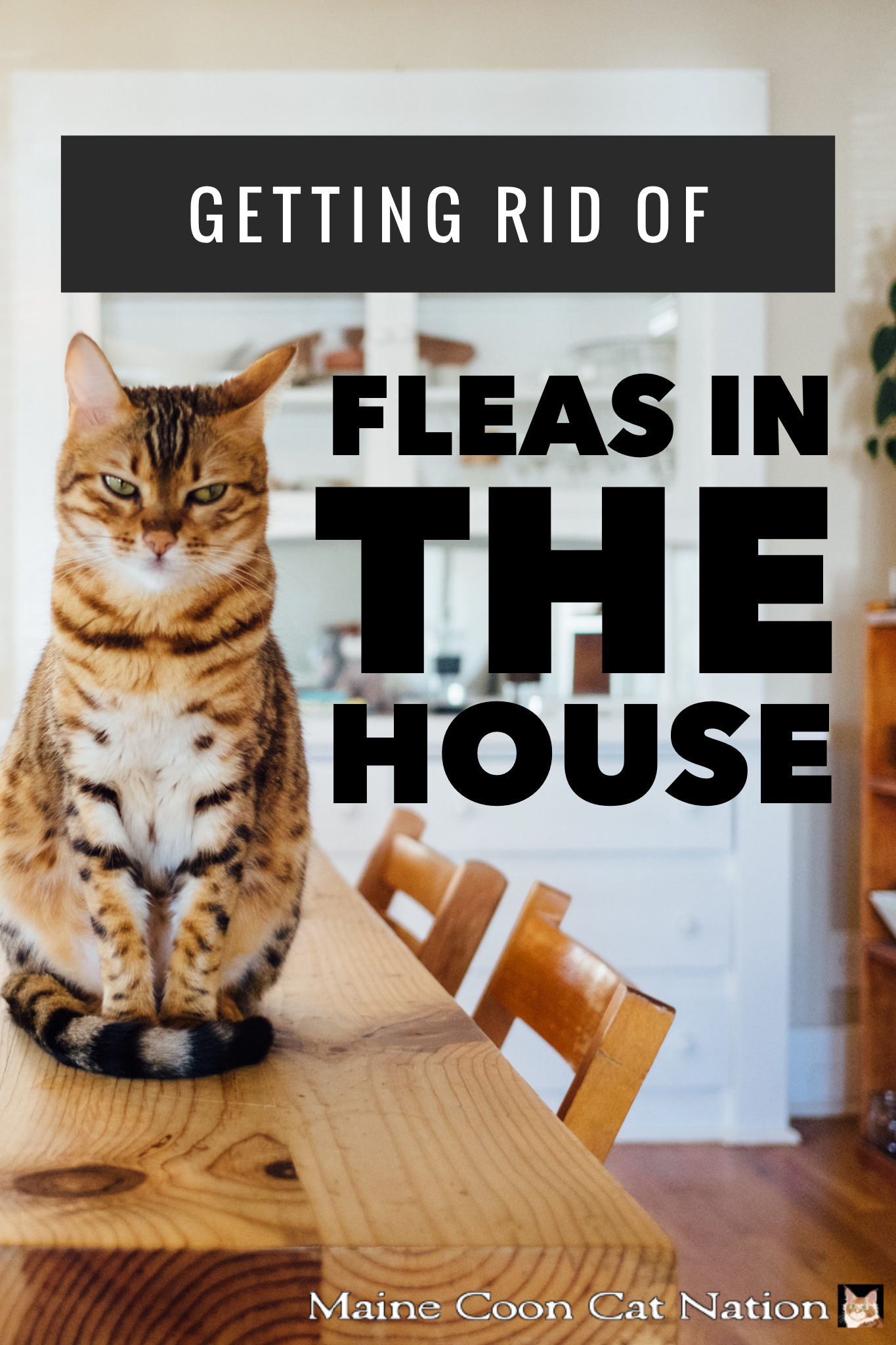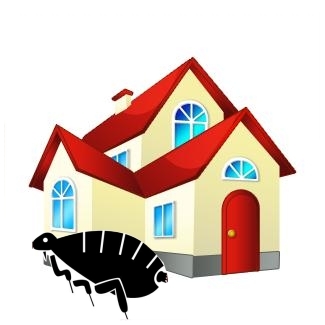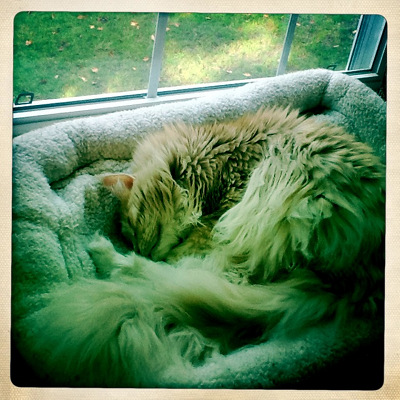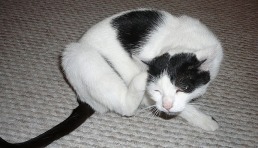- Home
- Maine Coon Cat Health
- Fleas in The House
How to Get Rid of Fleas in Your House
Easy-to-Follow Guide
Often, people don't speak of finding fleas in the house.
If you like this, you'll love our fun, free Daily Digest!


It can be an embarrassing topic, but virtually every pet owner, even those with the cleanest homes, has had a flea problem at some point.
Welcome to the second page in this series.
If you haven't read it yet, I recommend the previous article, Top 8 Flea Facts as well. We used these 8 facts as keys to kill the fleas in our home.
These pests can affect any breed - and any home. No matter what kind of pet you have, the info here is for you.
If you currently have no pets, but for some reason there are fleas in the house, we'll discuss some tips and techniques for your situation, too.
They are horrible little home invaders. When they are on cats or dogs, they are in the home, too.
Table of Contents:
In The Beginning:
At first, you see one jumping black speck and hope there aren't too many more.
You take some measures, and then Wham! They are everywhere! In the carpets, the furniture, all over the pets, even you.
You have fleas in the house. It's terrible. You think, "How did I let this happen?" And then, "Why do they keep coming, no matter what I do?"
We got rid of fleas in the house, and so will you:

You start looking for natural sprays and powders, all the best products, you wonder if your pet needs Frontline, Advantage, or something else.
Then there are all the products with natural ingredients. Do they really work? Is there a magic formula for success?
We had quite a battle, we learned a lot, and I'm eager to share it all with you!
These are insidious, tiny creatures. They make themselves at home in your home before you even know they are there. Finding fleas in the house can cause an immediate sense of worry and panic.
The key to getting the best results is to act quickly and proactively. Waiting even a day before waging war can mean extra weeks of battling them. Here, we'll lay out a game plan.
Step One: Confirm Their Presence
"What do fleas look like?"
You suspect that there are fleas in the house. Your first clue may be an itching pet, seeing some "black dirt" or finding an actual bugger in the house.
This is the day to take action. One of our cats had an allergic reaction, so our first sign was actually her hot spots, skin irritation and hair loss.
Flea dirt: This is actually flea feces, or poop. It looks like tiny black specks. If you run a flea comb through your pet and see it, they are likely nearby.
To confirm it is droppings, wet it. Droppings are actually dried blood (their food source) and will turn reddish.

What do they look like? They look like tiny black specks. When they are first hatched they are smaller and darker.
They are also more active. This is because they need to feed.
Adult fleas or ones who have fed are a bit "fatter" with a brownish body.
They do not look like tiny black flies. They are dark, shiny, and have a trademark jump. They can walk on your pet, but usually you'll see them jump.
They jump high and fast, often disappearing before you have a chance to grab one.
They rarely stay in one spot long enough for you to lean in and look closely, trying to see exactly what it is.
It usually happens something like this: You will see a small black dot. You wonder what it is - a crumb, some lint hopefully.
Then it vanishes in the blink of an eye. That's when you know for sure. It's always a smart idea to try to see where it landed and kill it, though this is often impossible.
If you do get one, don't open your fingers to look at it. It'll jump away immediately. Put it in a cup or saucer of soapy water.
They can jump right off the surface of water, but if you make it soapy they'll be trapped. (Some people also crush it between their fingernails.)
Try to capture and kill every one you see. Letting them go means many more flea eggs will be laid in the home.
Step Two: Waging war
No doubt about it, this is an all-out war. As soon as you see fleas in the house, follow these steps:
1: Treat all your pets and wash your pet's bedding

The first thing to do is use a topical flea treatment, such as Frontline or Advantage.
If you don't have it in your home, go out and buy it immediately. If your vet is closed, try the local pet store.
Treat your pets as soon as possible. You can visit our page on Pet Flea Products to compare Frontline and Advantage.
Never, ever try to give your small pet a lower dose of these products, though!
Ask your vet about dosages for small pets, such as guinea pigs or rabbits. He or she will likely provide you with a specific, measured dose for your small pets.
Additionally, never give a reduced dose of dog treatment to a cat. When it comes to topical applications, never mix and match.
If you are a new pet owner, or new to the subject of "topical treatment," here is a primer for you.
Topical treatment refers to a liquid formula that is applied directly to your pet's skin.
The place to do this is on your pet's back, between the shoulder blades. The reason for this location is that pets are less able to lick it off there.
These products are pesticides. It is one of the few occasions where loving pet owners would actually apply a chemical pesticide directly to the skin of their fur-baby.

Yet, given this situation, many believe that these effective products are the best choice.
As with any pesticide, there is a slim chance of individual negative reaction. Because of this, many pet owners choose to take a natural approach, using natural and homemade killers.
Such natural methods can work. They require more persistence and regular application.
It may take longer, but for many it is worth the peace of mind that comes with avoiding pesticides. Further down, we'll discuss some of these natural remedies for both pet application and for use around the home.
Wash pet bedding in a washing machine using the hot water setting and dry in the dryer.
If your pets like to lounge on your bed, you'll want to wash all of your own bedding as well. Flea eggs will have fallen off your pet and be in the bedding.
Important Insider Tip:
Don't bathe your pet within 48 hours of applying the treatment (before or after).
The box may say you can bathe your pet as soon as it's dry, but waiting 48 hours is known to ensure its effectiveness.
2: Vacuum Floors And Furniture To Kill Fleas In The House
The next step is to thoroughly vacuum your entire house immediately.
If you have a canister-style vacuum with a hose that can get under furniture and in corners, all the better. This can't be stressed enough!
If you have hardwood floors, pay special attention to any cracks between the boards and to the seam where floor and moulding meet.
These are areas that flea larvae will have wriggled to - dark corners and crevices where they will pupate.
Vacuuming is the single most underrated and one of the most effective ways to get rid of fleas in the house!
Take time to cover every inch of your home, every day for a while. If you can, take turns with another family member.
Want to supercharge your vacuuming effort, making it as effective as possible?
Sprinkle some of the very popular FleaBusters powder in corners, cracks, and crevices. This effective powder destroys them by direct contact.
Store the vacuum cleaner bag outside, in a trash bag between uses. Fleas can hatch and escape, which you don't want happening in the house!
3: Set A Trap To Kill Fleas In The House
These pests don't spend all their time on pets. They hang out in carpets, furniture, and crevices.
We had a great deal of success with homemade flea traps. At night before bed, set out a tray or saucer of soapy water on the floor near furniture or along the edge of a room.
If the saucer is white, even better. Place a small lamp or a nightlight near it. They will be attracted to the warmth and light and jump right in.
4: Vacuum!
5: Bathe your pets

After 48 hours, give every furry friend a bath and repeat as necessary.
Your pets, even cats, will appreciate feeling fresh and clean (not crawly!) Many people report that Dawn dish soap makes a pretty effective natural flea killer.
It must remain sudsy and on the flea itself for ten minutes to do its job, before rinsing.
To make the bath even more effective, use vinegar as well. There are details and instructions on our page all about the ways vinegar can be used. It's one of the best natural tricks around!
Now, I consider myself a natural kind of gal, and I gave the natural approach a go.
In my experience, the Dawn bath did not work. I left it on for 20 minutes, reapplied it, everything. The wet, soapy cats were still crawling with fat, happy pests.
Adding a vinegar rinse made a big difference (I am quite impressed with it), but this approach can't touch the effectiveness of actual flea shampoo. That's the way to go.
Perhaps a high quality natural flea shampoo is a suitable choice if you are avoiding chemicals?
During the bath, pay extra attention to your pet's head and face. Keep a comb handy to manually remove the buggers that will be trying to take refuge there.
Another method is to dip in a flea dip. Our recommendation is not to do this. These chemical dips are very strong.
They would have to be. Just dipping an animal kills these hard-shelled pests, so imagine the toxicity levels, and the amount of chemicals involved.
Different dips contain different active ingredients and chemicals, but they have one thing in common: pets have been known to become ill or worse after having a dip absorbed into their skin.
There are, however, natural dips available from retailers of natural pet products, so that may be a safer route.
6: The Complete Approach: Products For Killing Fleas In The House
To get down to business, you'll want to be equipped with supplies.
By treating your pets, home and backyard with reliable products, you'll eliminate these pests much more effectively.
There are many useful products on the market nowadays.
When it comes to severe infestations, flea bombs (or foggers) are a reliable choice. When bombing, make sure to follow the instructions, including vacuuming before.
The vacuum will stimulate flea pupae to hatch. This is critical, as the bomb won't kill fleas in the pupae stage of the flea life cycle.
Other popular products include flea shampoos and dips, powders, and flea spray.
Natural And Homemade Flea Killers
Natural flea killers can work! Many people swear by their effectiveness. Here are our top picks. You can find some of these right in your cupboard:
Vinegar: As discussed above, it is helpful in a bath. Some like to put it in their dogs' drinking water, too. For more information, be sure to visit our page on using vinegar.
20 Mule Team Borax is a product many use in their laundry. It's a white powder, similar to detergent.
This powder actually kills fleas. Sprinkle it on floors, carpets, and furniture. Leave overnight and vacuum before returning to the area. It remains in the corners and cracks, exactly where they are pupating.
Along the same lines, Fleabusters uses an extremely fine, statically charged Borate powder. It is applied in a similar manner, although you will want to use a mask and goggles during the meticulous application.
By following the directions precisely, the powder will remain in many cracks and crevices - killing fleas in the house even if there are no pets in the household!
Lemon is considered a natural bath and dip ingredient. I have not personally tried this one, but it's said that lemon kills fleas.
A flea comb is non-chemical, so it's a natural and safe way to remove them! Do not underestimate the power of combing out as many as possible, before they have a chance to reproduce.

Products To Avoid:
In addition to those harsh chemical dips, we don't recommend direct-application flea powder or collars.
The powder that is made to be applied directly to a pet is another chemical that will be all over their fur.
It will get shaken off their fur, and end up all over the house! Not to mention being ingested when your pet grooms him or herself!
Flea collars are also falling out of favor. Again, this is a toxic chemical that we are putting against our pets' skin.
These collars end up rubbing on our skin when we touch our pets. And, they are really not very effective!
Want to discover more products? The following products are discussed on our product page:
- The Top topical treatments
- Flea bomb, or fogger
- Shampoo
- Fleabusters and diatomaceous earth - 2 handy powders
- Spray
- Comb
- Brewers Yeast - garlic tablets
- The Victor Trap
- Ortho bug treatment for lawns
7: You guessed it. Vacuum!
It's tedious, it's tiring, and it takes up valuable time. It's one of the things you least want to do.
But vacuuming kills these pests in all phases of the flea life cycle.
Doing it daily kills fleas in the house so much faster than using only other methods. When we were in "the thick of it" we took turns vacuuming so it would get done almost every evening.
One last tip on how to kill fleas in the house: There must not even be one left behind!
If even one gets away on a carpet, vacuum that room immediately.
If you spot one in a bedroom and lose it, vacuum that room immediately. If you see one on your sock, don't just flick it away - kill it.
Please note: You'll want to keep the vacuum bag outdoors. Dispose of it or keep it outdoors between uses since you'll be running the vacuum frequently.
Step Three: Control and Maintenance - Preventing Future Infestations
After all your diligent work, the invaders are gone, and you never want to endure another flea infestation!
Keep administering a topical treatment to your pet. Don't miss a dose. Make sure that any other animals who come to visit are treated as well.
And if you are just getting over an infestation, keep dosing through the winter. If you live in a warm climate you'll want to dose through the winter anyway.
Take care of your lawn by applying an outdoor treatment. These pests and other parasites can multiply and spread like wildfire outdoors in the right weather.
Find a high-quality pest control treatment to make sure no pests return to the home. Consider hiring the services of a professional exterminator.
Along with taking care of pests such as ants, termites and mosquitoes, many will also offer a specific flea control program.
After reading these articles, you may be looking for even more information.
We recommend a fresh new website with special sections just for fleas on dogs, on cats, in the home and much, much more. For a thorough resource, check out FleaGuide.com!
Getting rid of these pests can be really challenging. That's why we've created an effective, easy-to-follow action plan on our 'cousin' site, FleaGuide.
Because we know you want to stop searching the internet - you need these pests eliminated, now!
Once you reach this point (and you will!) you'll never again have to worry about how to kill fleas in the house.
FAQ's (frequently asked questions):
"Will they eventually go away on their own?"
"Will they eventually go away on their own?"
No. Unfortunately as long as any animals or humans live in the house, they will continue to feed and multiply.
"What kills fleas instantly in my house?"
"What kills fleas instantly in my house?"
The most powerful, fastest approach is to apply a treatment to your cats and dogs, then wash all bedding, and vacuum floors as soon as possible.
Consider using a steam cleaner as well. There is no one-product shortcut.
"How long does it take to get rid of fleas in the house?"
"How long does it take to get rid of fleas in the house?"
The rule of thumb is 3-4 months, as the remaining eggs, larvae and pupae go through the life cycle.
But, if you apply a topical treatment, you'll notice a difference in about 24 hrs and a marked population reduction in a few days.
« Back to Maine Coon Health

